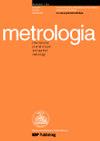NMIA 和 NMIJ AIST 之间白银凝固点温度的本地化比较
IF 2.4
3区 工程技术
Q2 INSTRUMENTS & INSTRUMENTATION
引用次数: 0
摘要
关键比对 CCT-K4.1 是应澳大利亚国家计量研究院 (MNIA) 的要求发起的,目的是将其标准与温度测量咨询委员会 (CCT) 的关键比对 (KC) 重新链接,并方便 NMIA 提交 CMC。日本国家计量研究院(NMIJ)提供了银凝固点温度与 CCT-K4 的链接。在 CCT-K4 完成时,NMIA(前身为 CSIRO-NML)只有一个银电池,而且在完成后不久就发现受到污染。随后,在 CCT.K4.1 开始之前,又在不同时间制造了更多的银电池,形成了五个银电池的组合。在 CCT-K4.1 双侧对比中,使用了 NMIA 提供的银电池作为人工制品,并按照试点--参与方--试点计划进行了流通。NMIJ 的标准做法是使用纯度为 6N 的氩气和 NMIA 纯度为 5N 的氩气来调节银电池中的压力。为了减轻这种情况,在后循环测量中评估了不同氩气纯度的影响。首先在 6N 纯度气氛下进行比较,以保持银电池离开 NMIJ 后的环境,然后在 5N 氩气气氛下重复测量。通过 NMIA 参考银定点和 NMIJ 参考银定点之间的温度差(与 CCT-K4 的 KCRV 相联系),根据 NMIJ 参考银定点的温度与 CCT-K4 在银定点的关键比较参考值 (KCRV) 相联系。NMIA 标准与 CCT-K4 的 KCRV 之间的温度差在 CCT-K4.1 的评估比较不确定度范围内。本报告详细介绍了比对结果、联动机制以及 NMIA 相对于参与 CCT-K4 的机构的等效度。要阅读本文正文,请点击最终报告。请注意,该文本是 BIPM 关键对比数据库 https://www.bipm.org/kcdb/ 附录 B 中的文本。根据 CIPM 互认安排(CIPM MRA)的规定,最终报告已经过同行评审,并获准由 CCT 发布。本文章由计算机程序翻译,如有差异,请以英文原文为准。
Comparison of local realizations of Silver freezing-point temperatures between NMIA and NMIJ AIST
The key comparison CCT-K4.1 was initiated on the request of the National Measurement Institute, Australia (MNIA) to re-link their standards to the Consultative Committee for Thermometry (CCT) Key Comparison (KC) and facilitate the NMIA CMC submission. National Metrology Institute of Japan, Japan (NMIJ) provided the linkage to the CCT-K4 at the temperature of the freezing point of silver. At the time of the CCT-K4 NMIA (formerly CSIRO-NML) had only one silver cell and this was found to be contaminated shortly after completion. Subsequently, more silver cells were fabricated at different times to form an ensemble of five cells before the start of CCT.K4.1. In the CCT-K4.1 bi-lateral comparison, a silver cell provided by NMIA and used as the artefact and circulated in accordance with the pilot-participant-pilot scheme. It is standard practice for NMIJ to use argon at 6N purity and NMIA argon 5N purity to regulate the pressure in the silver cell. To mitigate this, the effect of different argon purity was assessed in the post-circulation measurements. First the comparison was made under 6N purity atmosphere to preserve the cell ambience after it left NMIJ then the measurement was repeated under 5N argon atmosphere. The linkage was based on the temperature of NMIJ reference Ag fixed point relative to the key comparison reference value (KCRV) of CCT-K4 at the Ag fixed point via the difference in temperature between the NMIA reference Ag fixed point and NMIJ reference Ag fixed point (links to the KCRV of the CCT-K4). The temperature difference between the standards of NMIA and the KCRV of the CCT-K4 was within the evaluated comparison uncertainties of the CCT-K4.1. This report provides detailed information on the comparison results, linkage mechanism, and the Degree of Equivalence of NMIA relative to the institutes having participated in the CCT-K4. To reach the main text of this paper, click on Final Report. Note that this text is that which appears in Appendix B of the BIPM key comparison database https://www.bipm.org/kcdb/. The final report has been peer-reviewed and approved for publication by the CCT, according to the provisions of the CIPM Mutual Recognition Arrangement (CIPM MRA).
求助全文
通过发布文献求助,成功后即可免费获取论文全文。
去求助
来源期刊

Metrologia
工程技术-物理:应用
CiteScore
2.80
自引率
25.00%
发文量
137
审稿时长
12 months
期刊介绍:
Published 6 times per year, Metrologia covers the fundamentals of measurements, particularly those dealing with the seven base units of the International System of Units (metre, kilogram, second, ampere, kelvin, candela, mole) or proposals to replace them.
The journal also publishes papers that contribute to the solution of difficult measurement problems and improve the accuracy of derived units and constants that are of fundamental importance to physics.
In addition to regular papers, the journal publishes review articles, issues devoted to single topics of timely interest and occasional conference proceedings. Letters to the Editor and Short Communications (generally three pages or less) are also considered.
 求助内容:
求助内容: 应助结果提醒方式:
应助结果提醒方式:


